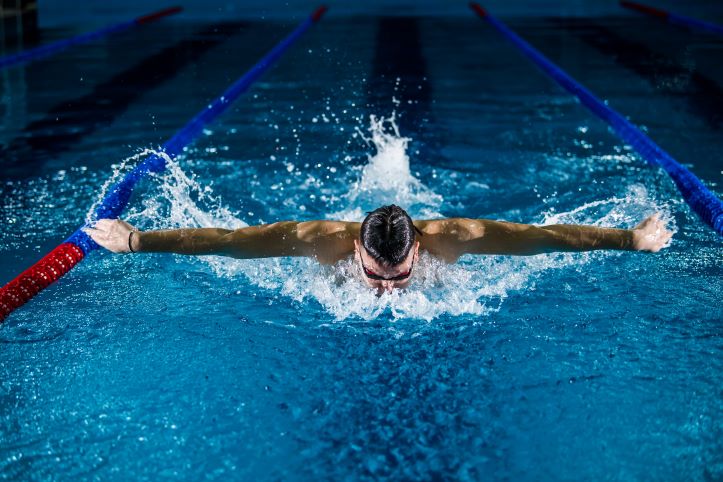Dive into the refreshing world of swimming as we uncover the hidden gem known as the butterfly stroke. In this article, we’ll dip our toes into the water and explore the butterfly stroke benefits. A graceful combination of powerful arm sweeps and rhythmic leg kicks that propel you through the water with an unmatched blend of beauty and strength. As we unravel the secrets behind this majestic stroke, you’ll not only grasp its form but also understand the profound impact it can have on your well-being.
Get ready to glide through our guide, where each lap of information brings you closer to a deeper comprehension of the butterfly stroke’s advantages. Let’s go off on an adventure that reveals the wonderful range of benefits this stroke has to offer, from strengthening muscles to developing mindfulness.
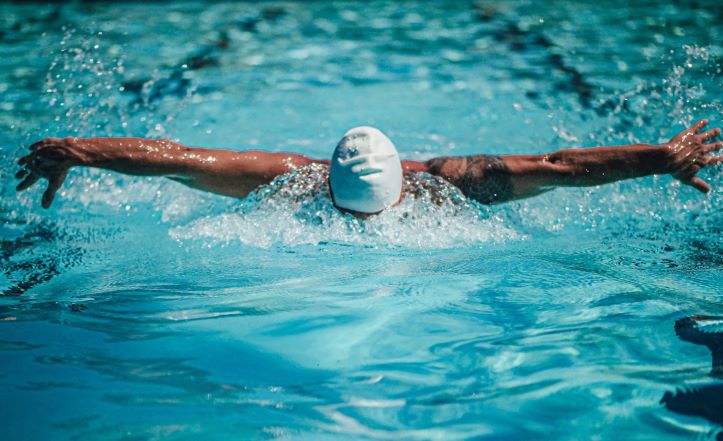
What is Butterfly Swimming?
The butterfly stroke, often dubbed the “fly,” is a distinctive swimming style that demands both athleticism and finesse. It’s characterized by the simultaneous movement of both arms in a circular pattern, accompanied by a coordinated dolphin-like kick. This harmonious choreography creates a mesmerizing undulation, propelling the swimmer forward with a fluid yet forceful grace.
A true spectacle to behold, butterfly swimming showcases the swimmer’s mastery over water dynamics. It’s a stroke that bridges the gap between art and sport, where strength meets style in a display of aquatic elegance. Whether you’re a novice or an experienced swimmer, exploring the world of butterfly swimming opens the door to a realm of physical prowess and artistic expression, where the water becomes your canvas and the strokes your brushstrokes.
Who Invented Butterfly Swimming?
The butterfly stroke, with its distinctive simultaneous arm movements and undulating body motion, has a fascinating history that can be traced back to the early 20th century. However, pinpointing a single individual as the sole inventor of the butterfly stroke is a bit like navigating the waves – there are a few notable names that contributed to its development.
David Armbruster
In the 1930s, David Armbruster, a coach at the University of Iowa, played a significant role in shaping what we recognize today as the butterfly stroke. He sought to create a new style that combined elements of the breaststroke and the front crawl, aiming for a more efficient and powerful technique.
Jack Sieg
Jack Sieg, a swimmer from the same era, is often credited with refining Armbruster’s ideas. Sieg’s experimentation with arm movements and coordination helped to further mold the stroke into its recognizable form. His contributions were pivotal in transitioning the butterfly stroke from an experimental concept to a competitive swimming style.
Butterfly Evolution
Interestingly, the butterfly stroke underwent several modifications over the years. Swimmers and coaches around the world continued to refine the stroke’s technique and mechanics. This evolution was fueled by a desire to strike a balance between speed and efficiency while adhering to evolving swimming regulations.
In 1952, the butterfly stroke was officially recognized as a distinct swimming style by FINA, the international governing body for competitive swimming. This recognition solidified the stroke’s place in the swimming world and paved the way for its inclusion in competitions and Olympic events.
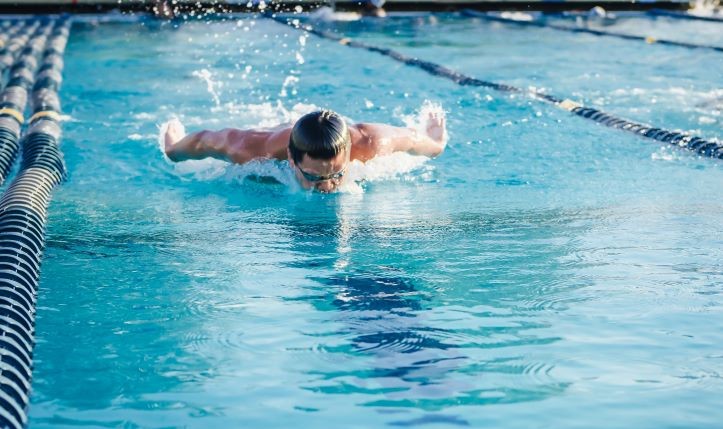
6 Types of Butterfly Swimming Styles
Welcome to the fascinating realm of butterfly swimming. Here the water becomes a canvas for different strokes of elegance and power. In this section, we’re diving into the various types of butterfly swimming styles that add flair and versatility to this captivating swim technique.
Traditional Butterfly Stroke
The traditional butterfly stroke serves as the foundation for all other styles. It’s characterized by the rhythmic coordination of arm movements, where both arms simultaneously sweep out of the water, propel forward, and then re-enter. This classic style showcases the undulating body motion that defines butterfly swimming.
Dolphin Kick Butterfly
Picture a dolphin’s smooth and rapid kick – that’s the essence of the dolphin kick butterfly. Swimmers in this style forgo the traditional arm strokes and rely solely on the powerful dolphin kick for propulsion. It’s a streamlined approach that demands exceptional core strength and a well-honed kick technique.
Modified Butterfly
For those seeking a balance between the demanding traditional stroke and the ease of other styles, the modified butterfly comes into play. Here, swimmers use a less pronounced arm movement while retaining the distinct dolphin kick. It’s a great way to experience the beauty of butterfly swimming without the full intensity of the traditional stroke.
Butterfly Drill Variations
Drills are essential for refining technique, and butterfly swimming is no exception. Various drill variations focus on isolated aspects of the stroke, such as arm movement, body position, and breathing coordination. These drills allow swimmers to hone specific skills and gradually build up to the complete stroke.
Underwater Dolphin Kick
A favorite among competitive swimmers, the underwater dolphin kick showcases the power of the lower body. Swimmers execute a series of rapid dolphin kicks while submerged, propelling themselves underwater with incredible speed and minimal resistance. This style is often used during starts and turns in races.
Hybrid Styles
Swimmers often experiment with hybrid styles that combine elements of butterfly with other strokes, such as the freestyle or backstroke. These creative blends can enhance speed, conserve energy, or simply add variety to training routines.
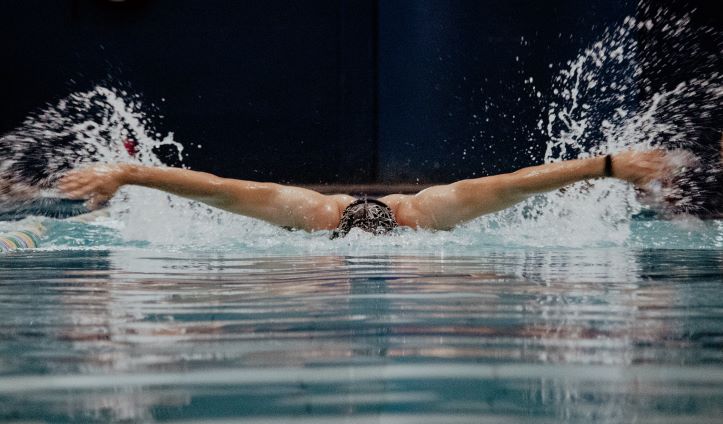
Best 8 Butterfly Stroke Benefits
# Full-Body Workout Wonder
Prepare for a holistic muscle-engaging experience with the butterfly stroke. From head to toe, this stroke orchestrates a harmonious workout for your body. Your arms gracefully slice through the water, sculpting your upper body while igniting your core muscles. Your legs perform a powerful ballet, propelling you forward and toning your lower body.
But the magic doesn’t stop there. Your back muscles come into play as you maintain fluid movement, ensuring a strong and balanced physique. It’s like a symphony of strength where every muscle has a part to play. The butterfly stroke leaves no stone unturned, making it the ultimate full-body workout in the pool. So, dive in, let your body flow, and emerge stronger, more toned, and ready to take on the world with confidence.
# Cardiovascular Splendor
Swimming the butterfly stroke isn’t just about graceful movement – it’s a secret weapon for your heart. Those fluttering arm and leg motions create a heart-pounding symphony that strengthens your heart muscle and improves your lung capacity. This stroke is your ticket to a healthier, more resilient cardiovascular system that keeps you energized and ready to seize the day!
# Posture Perfect
The butterfly stroke, a powerful aquatic gem, turns this dream into reality. As you gracefully move through the water, it’s not just your muscles getting a workout – your back muscles are also benefiting. By targeting and strengthening these muscles, the butterfly stroke naturally encourages proper alignment of your spine, leading to that sought-after tall and confident posture. It’s like a gentle reminder from the water to stand tall, embrace grace, and radiate confidence in every step you take.
# Flexibility Boost
This stroke isn’t just about movement; it’s a gateway to newfound flexibility. As you glide through the water, your shoulders and hips become partners in an elegant dance. The stroke demands a remarkable range of motion from these pivotal joints, gently coaxing your body into becoming more supple and agile.
Think of it as a yoga class, minus the intricate contortions. The butterfly stroke’s sweeping motions embrace your body’s natural flexibility potential. Your shoulders experience liberation, and your hips find a newfound freedom. With every stroke, you’re nurturing a fluidity that transcends the water – it becomes a part of you. So, dive into the waters, wave stiffness goodbye, and say hello to a body that moves with grace and ease, both in the pool and beyond.
# Lung Capacity Boost
While the butterfly stroke showcases its elegance in the water, it’s also secretly enhancing your lung capacity. As you gracefully move through the pool, the deliberate breathing rhythm becomes your ally. This controlled inhalation and exhalation pattern doesn’t just support your stroke; it also expands your lung capacity.
With each stroke, your respiratory muscles work in harmony, pulling in more oxygen and releasing carbon dioxide efficiently. This not only improves your swimming performance but also boosts your overall respiratory health. Whether you’re gliding through the water or tackling daily activities, your enhanced lung capacity leaves you feeling more energized and revitalized. So, let every stroke be a breath of fresh air, enriching your lungs and elevating your aquatic experience.
# Calorie Burn Champion
It’s not just a stroke; it’s a fat-fighting powerhouse. Each graceful move in the water turns into a calorie-burning fiesta that leaves you feeling accomplished and closer to your healthy weight goals.
As you glide through the water, your body engages a multitude of muscles, demanding energy and torching calories. This stroke’s dynamic nature amps up your metabolism, turning your pool time into a workout that’s both effective and enjoyable. Whether you’re aiming to shed a few pounds or maintain your ideal weight, the butterfly stroke is your trusty companion on this calorie-burning journey. So, jump in, splash around, and watch those extra calories sizzle away!
# Mental Oasis
The butterfly stroke isn’t just a physical endeavor; it’s a pathway to mental serenity. Its rhythmic cadence creates a soothing symphony for your mind, washing away stress like a cool breeze on a warm day.
With each stroke, your mind finds solace in the repetitive motion. It’s a moving meditation that lets you disconnect from the hustle and bustle of daily life. As you glide through the water, worries dissipate, and calmness takes over. The butterfly stroke becomes your secret haven, a place where stress evaporates and peace prevails. So, jump in and let the water’s embrace be your mental oasis, offering respite from the chaos and leaving you refreshed, renewed, and ready to face the world with a tranquil smile.
# Core of Steel
With its undulating motion, this stroke doesn’t just skim the surface; it delves deep into your core muscles, transforming them into a fortress of strength and stability.
As you glide and flutter through the water, your core becomes the epicenter of the action. The continuous engagement of your abdominal muscles is like a workout tailored just for them. It’s not just about aesthetics; a strong core supports your posture, balance, and overall functionality. The butterfly stroke’s rhythmic challenge refines your midsection, leaving you with a core of steel that’s ready to take on anything life throws your way. So, dive in and let your midsection embrace the strength it deserves, all while enjoying the elegance of the butterfly stroke’s movements.
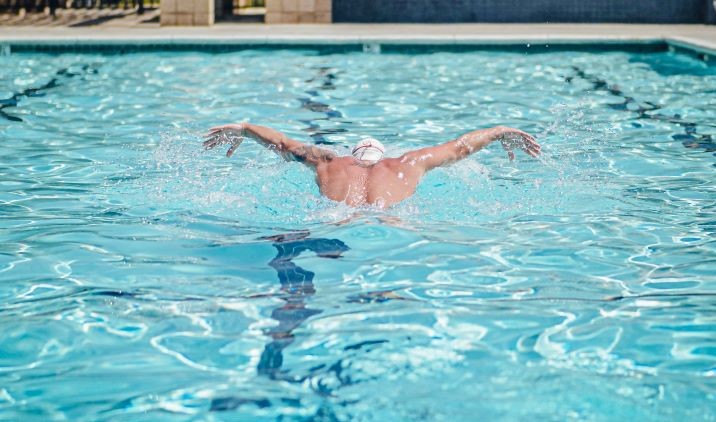
How to Do Butterfly Swimming? Techniques for Butterfly Swimming
As you have known the butterfly stroke benefits, now you should learn the techniques for butterfly swimming. Butterfly swimming, often referred to as the “fly”. It is one of the most challenging and graceful strokes in competitive swimming. The fluid motion of the butterfly stroke is both mesmerizing to watch and exhilarating to perform. However, mastering this technique requires dedication, practice, and a solid understanding of the stroke’s mechanics.
Body Position
Achieving the correct body position is crucial for efficient butterfly swimming. To maintain a streamlined profile in the water, follow these steps:
- Keep your body parallel to the water’s surface, with your hips and shoulders in line.
- Extend your arms forward and keep them close together.
- Your head should be looking down, with your face submerged just below the water’s surface.
- Maintain a straight body line with minimal undulation.
Arm Movement
The arm movement in the butterfly stroke consists of a simultaneous, symmetrical motion of both arms. Follow these steps for efficient arm movement:
- Start with your arms extended forward and your hands close together.
- Pull both arms simultaneously, sweeping them outwards and downwards in a circular motion.
- As your hands move towards your hips, bend your elbows slightly.
- The recovery phase involves lifting your arms out of the water simultaneously, keeping them close to the surface, and extending them forward again.
Leg Movement
The leg movement in butterfly swimming is characterized by a simultaneous, undulating motion. Here’s how to perform the leg movement correctly:
- Begin with your legs extended and close together.
- Simultaneously kick both legs, performing a fluid, wave-like motion.
- Keep your feet pointed, and avoid excessive splashing.
- The kick should originate from the hips, not the knees.
Breathing
Proper breathing is essential in butterfly swimming. Unlike other strokes, the butterfly requires a coordinated head movement for breathing. Here’s how to breathe while swimming butterfly:
- As your arms start to sweep outwards and downwards, lift your head slightly out of the water to take a breath.
- Breathe as your arms reach the widest point of their outward sweep.
- Exhale while your arms recover and extend forward underwater.
Timing and Rhythm
Maintaining the right timing and rhythm is vital for a smooth and efficient butterfly stroke. Focus on these aspects:
- The arm and leg movements should be synchronized, with the arms entering the water as the legs kick downward.
- Achieving a rhythm that minimizes resistance is key to efficient butterfly swimming.
Practice and Progression
Butterfly swimming can be physically demanding and challenging to master. It’s essential to practice regularly and gradually build your stamina and technique. Start with shorter distances and gradually increase the length of your swims as your proficiency improves.
Seek Coaching
If you’re serious about improving your butterfly stroke, consider working with a qualified swim coach. They can provide personalized feedback, drills, and exercises to help you refine your technique and reach your full potential as a butterfly swimmer.
Tips for Perfecting Your Butterfly Strokes
Mastering the butterfly stroke might seem like a challenge, but with the right techniques, you’ll be gliding through the water like a pro. Here are some essential tips to help you nail those graceful and powerful strokes:
Start with Basics: Begin with a strong foundation. Focus on mastering the arm movements, body undulation, and leg kicks separately before integrating them into a cohesive stroke.
Timing is Key: Coordinate your arm movements and leg kicks in sync. The arm pull and leg kick should complement each other, creating a fluid and efficient motion.
Core Engagement: Your core is your powerhouse. Keep your core muscles engaged throughout the stroke to maintain stability and generate power.
Breathe with Rhythm: Breathing in the butterfly stroke can be a challenge. Inhale as your arms come out of the water, and exhale as you push them down. Find a breathing rhythm that suits you.
Stay Horizontal: Maintain a horizontal body position by keeping your hips and shoulders close to the water’s surface. This reduces drag and helps you glide effortlessly.
Relaxed Neck: Keep your neck relaxed and aligned with your spine. Look slightly forward to avoid straining your neck muscles.
Practice Drills: Incorporate drills that isolate specific components of the stroke. This helps in refining your technique and building muscle memory.
Build Gradually: Don’t rush your progress. Start with short distances and gradually increase as your technique improves and stamina builds.
Video Analysis: Record yourself swimming butterfly and analyze it to identify areas for improvement. Compare it with professional swimmers’ videos for inspiration.
Seek Professional Guidance: If possible, work with a swimming coach. Their expert guidance can make a significant difference in perfecting your butterfly stroke.
Conclusion
The butterfly stroke stands as a testament to grace, power, and the art of mastering the water. With its distinctive name inspired by butterfly wings and its captivating movements, this stroke offers more than just a physical challenge – it’s a journey of self-discovery. From sculpting muscles to boosting cardiovascular health and offering a mental escape, the butterfly stroke is a holistic experience.
So, whether you’re a seasoned swimmer or dipping your toes into the pool for the first time, let the butterfly stroke be your guide. Embrace the water, embody its elegance, and glide towards a stronger, fitter, and more vibrant version of yourself.
If your swimmer athlete is lazy, learn how to motivate a lazy athlete and get him/her powered up.
FAQs
Does butterfly stroke build muscle?
Yes, butterfly stroke can help build and tone muscles, especially in the upper body and core. It greatly affects the chest, shoulders, back muscles, and arms. It’s an excellent full-body workout for strength and endurance.
Is butterfly the hardest stroke?
Many swimmers consider the butterfly stroke to be the most challenging due to its technical demands and physical exertion. However, the difficulty may vary from person to person, depending on individual strengths and weaknesses.
Is butterfly stroke good for back?
Butterfly stroke can be good for the back as it engages the muscles of the upper back and helps improve posture. However, it’s essential to maintain proper form to avoid strain or injury. If you have back issues, consult a healthcare professional before starting a butterfly swimming regimen.
Which muscles does butterfly work?
Butterfly stroke primarily works the shoulders, chest, core, legs, upper back, and glutes, providing a comprehensive full-body workout.
Is butterfly stroke good for weight loss?
Yes, butterfly stroke can be effective for weight loss, as it’s a high-intensity, calorie-burning exercise that engages multiple muscle groups.
Is butterfly exercise reduce thigh fat?
Butterfly swimming can help tone and strengthen the leg muscles, but it may not specifically target thigh fat reduction. A combination of a well-rounded fitness routine and a healthy diet is more effective for overall fat loss, including the thighs.
Why is butterfly stroke called butterfly?
The butterfly stroke earned its name because of the way the arm movements resemble the graceful and rhythmic motion of a butterfly’s wings when seen from underwater. The stroke’s elegance and fluidity inspired the name.


